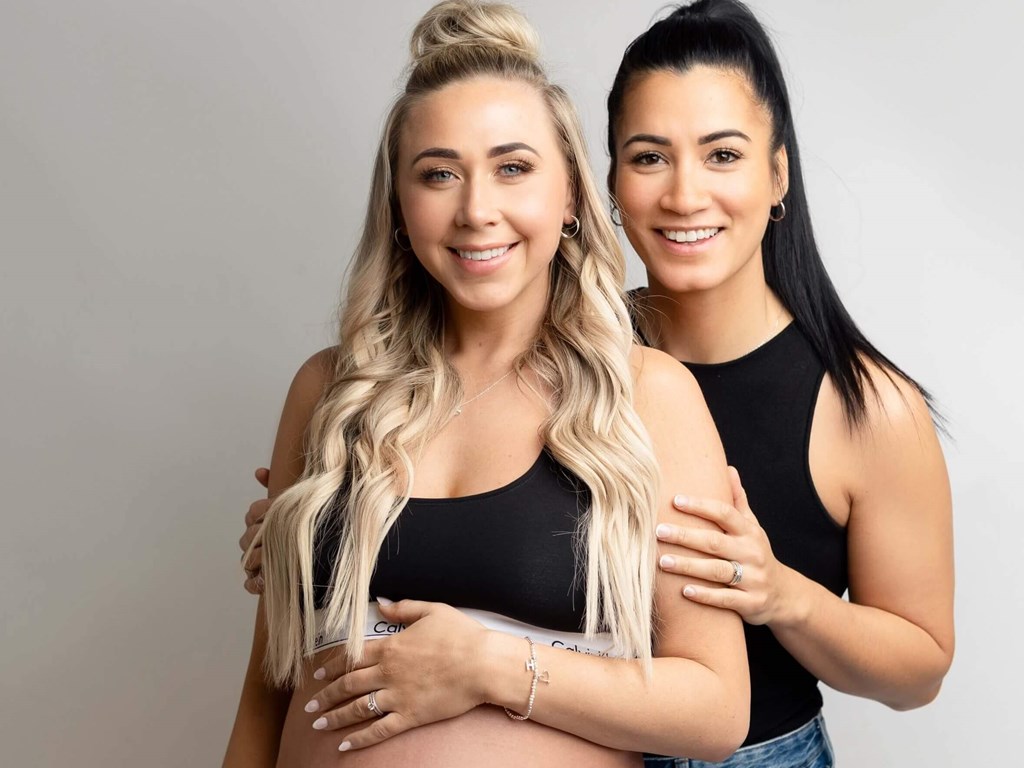Pregnancy options for lesbian couples: What you need to know
Many couples dream of becoming parents, and modern fertility treatments make this dream easier to achieve. This blog post focuses on the different options for fertility treatment if you want to start a same-sex family.

Parenthood comes in many forms and over the last years, more and more same-sex couples choose to get fertility treatment. According to the HFEA, the number of same-sex couples having IVF increased by 45% from 2019 to 2023.
The most common fertility treatment options include IUI, ICI, IVF and Reciprocal IVF. But which type of treatment is right for you?
If you are just beginning to explore your options or are already considering treatment, understanding the differences between these methods will help you to make an informed choice.
This blog post will explain how each treatment works and outline what to consider before starting your fertility journey.
Four common fertility options for lesbian couples
There are different ways to get pregnant with donor sperm when you’re in a same-sex relationship. Four popular fertility treatments are intrauterine insemination (IUI), intracervical insemination (ICI), in vitro fertilisation (IVF) and reciprocal IVF.
Each type of treatment comes with different considerations such as procedures, complexity and cost. It is usually your doctor or fertility clinic who will help you decide which treatment is right for you.
To help you get an overview of your options, we have gathered information about them here.
IUI
IUI is often the first choice of treatment, if you or your partner have no known fertility challenges. The process involves placing donor sperm directly in the uterus around ovulation. For some, it can be necessary to take medication before the time of insemination.
Compared to IVF, IUI is more simple and less invasive. This also makes the procedure less expensive. IUI tends to have lower success rates than IVF, but it is important to remember that these statistics often include people having fertility challenges. Many same-sex couples have a good ovarian reserve and no fertility challenges.
ICI
Another type of insemination is ICI. The difference between ICI and IUI lies in the procedure.
If you’re having ICI treatment, donor sperm will be placed near the cervix. This makes it possible for sperm cells to travel naturally to the uterus and the fallopian tubes. Sometimes it is necessary to use fertility medication, but it all depends on your situation.
As ICI mimics the process of natural conception, it might require more rounds of treatment.
IVF
If you have experienced multiple failed IUI treatments or know you have fertility challenges such as blocked fallopian tubes, PCOS or endometriosis, IVF might be relevant for you. This type of treatment involves using hormonal medication to produce several eggs. The eggs are then retrieved and fertilised in a lab, before being placed back in the uterus.
In general, IVF has higher success rates than other types of fertility treatment, but it is also more expensive.
Reciprocal IVF (Shared motherhood)
Reciprocal IVF, or shared motherhood, is another way of getting pregnant as a same-sex couple where both partners can feel connected to the pregnancy. Eggs are retrieved from one partner and fertilised as normal IVF. When they have developed in the lab, they are placed in the other partner’s uterus. This means that both partners are physically involved in the pregnancy - one donates the eggs, the other carries the pregnancy.
Reciprocal IVF can be a great choice for same-sex couples, but remember that it is not allowed in all countries.
Choosing a donor as a lesbian couple
An exciting, and sometimes overwhelming, part of starting a family as a same-sex couple is choosing a sperm donor together. There can be many things to consider so it’s a good idea to choose a couple of criteria that you prioritise.
For some same-sex couples it is important that the donor looks like the non-biological parent. To make that process easier, you can use tools like Photo Match to narrow down your search.
Other couples prioritise to focus on the donor’s background or personality - maybe you find it more important to choose a donor with a specific hobby.
Here’s a good tip: Create a shortlist of donors so you have more donors to choose from if you need to change donor during your fertility treatment.
ID release or No ID release donor?
Choosing a sperm donor for your same-sex family also means considering if you want a ID release or a No ID release donor.
If you choose an ID release donor, your child will be able to get information about the donor’s identity if they want to when they reach legal age. That is not possible with a No ID release donor.
The choice between ID release and No ID release donors often comes down to what feels right for your family. It’s a personal decision and one worth taking time to discuss together. Remember though that in some countries, like the UK, only ID release donors are allowed.
If you’re unsure about the rules in your treatment country, we can help you with guidance. You can also read more about the process of starting a family in our guide for same-sex couples.
Planning your treatment journey
Once you have decided to start a family, the next step is to plan how and when to begin treatment. There are a few things you should consider and be aware of when planning your journey.
Who’s carrying the pregnancy?
One of the first things you've got to figure out as a same-sex couple is who's going to carry the baby. Some couples already have a strong preference, some choose to carry a pregnancy each if they want more children and others decide based on medical aspects like age, ovarian reserve or overall health. That’s why it is a good idea to get a fertility assessment so you know if there is anything you need to be aware of.
Hear about how Laura and Eva chose to start their same-sex family.
Legal considerations for same-sex couples
Access to fertility treatment and legal parental rights for same-sex couples differ from country to country. Researching your options and the legal landscape in your country is an important step in your preparation for your fertility treatment. Be sure to check local laws regarding donor types, age limits, and recognition of parental rights, especially if you’re planning treatment abroad. If you are unsure about your legal situation, you can always contact us for help.
Read Jo and Viv’s story and why they needed to travel abroad for fertility treatment.
Physical and emotional aspects of fertility treatment
Fertility treatment can involve taking fertility medication to stimulate ovulation or prepare the body for egg retrieval or embryo transfer. That depends on your situation and the kind of treatment you are having. If you need fertility medication as part of your treatment it is a good idea to be aware of the side effects that might show. Fatigue, mood swings and bloating are some of the physical side effects you may experience.
Having fertility treatment can also be an emotional roller coaster. Appointments, decision-making and waiting time can take up mental space. Remember to talk about the physical and emotional changes and be aware of supporting each other when things feel intense. Open communication is crucial and some couples also find it helpful to speak with a fertility counsellor or join an online community for emotional support.
Track your menstrual cycle
One of the things you can do to prepare for fertility treatment is to track your menstrual cycle. The timing of ovulation is very important, especially in procedures like IUI, where sperm is inserted directly into the uterus at the most fertile point. Many clinics will help you with ovulation tests, scans or blood tests, but knowing when you are ovulating can make things easier.
FAQs on lesbian pregnancy and IVF
Can two women have a biological child?
With a fertility treatment called reciprocal IVF (or Shared motherhood), both partners can play a physical role in the pregnancy. One partner provides the egg and the other carries the pregnancy.
How much does it cost for two women to have a baby?
Costs vary depending on the kind of treatment you're having and your treatment country. IVF and reciprocal IVF tend to be more expensive because they involve additional procedures and medication. You also have to remember the cost for donor sperm and if you are travelling abroad for treatment.
Can a woman carry another woman’s baby?
Yes, this is exactly what happens in reciprocal IVF. One partner provides the egg and the partner carries the baby. It's a meaningful way for both partners to take part in the journey - one as the biological parent and the other as the parent who gave birth to the baby.
Can you use donor eggs?
Yes. Donor eggs can be used when neither partner can (or wants to) use their own eggs. It may be relevant if both partners have a low ovarian reserve, age-related infertility or certain health conditions.
Ready to start your journey?
If you’re ready to take the next step, we’re here to help. Exploring donor profiles is a great way to start thinking about the future and deciding what matters most to you as a couple.
At European Sperm Bank, we support all family forms and whether you’re still weighing your options or ready to move forward, a free fertility consultation can provide clarity and reassurance. Our experienced advisors are happy to guide you through the process and answer your questions.
Read more
 Personal stories
Personal storiesHow Holly and Rumer chose their sperm donor after getting caught up in every little detail
Rumer and Holly put a lot of pressure on themselves to choose the “perfect” sperm donor for their family. Now that their son Freddie is here, all that worrying seems far less important.
 Guide
GuideWhat to consider about the future when you are starting a family with donor sperm
It is easy to get caught up in the present when you are starting a family with donor sperm. But it is a good idea to think about the future as well. Read on to learn more about what to consider.
 Personal stories
Personal storiesLaura and Eva went abroad to start a family
French couple Laura and Eva went to another country to get fertility treatment with donor sperm. Their journey was filled with ups and downs – and many logistical challenges. This blog post takes a closer look at the process of getting fertility treatment abroad.
 Anne Petersen
Anne Petersen